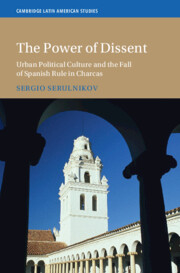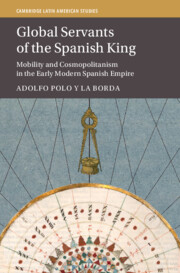Refine search
Actions for selected content:
38 results
2 - The Eighteenth-Century “Market” of Offices
-
- Book:
- The Venal Origins of Development in Spanish America
- Published online:
- 11 October 2025
- Print publication:
- 02 October 2025, pp 22-46
-
- Chapter
- Export citation

The Power of Dissent
- Urban Political Culture and the Fall of Spanish Rule in Charcas
-
- Published online:
- 07 August 2025
- Print publication:
- 07 August 2025
The cobs in the archaeological context of the San José Galleon shipwreck
-
- Article
-
- You have access
- HTML
- Export citation
Introduction
-
- Book:
- Global Servants of the Spanish King
- Published online:
- 20 February 2025
- Print publication:
- 27 February 2025, pp 1-25
-
- Chapter
- Export citation

Global Servants of the Spanish King
- Mobility and Cosmopolitanism in the Early Modern Spanish Empire
-
- Published online:
- 20 February 2025
- Print publication:
- 27 February 2025
Habsburg in Havana. Outsider Participation in the Spanish Empire: the Slaving Licence of Romberg & Consors of Ghent, 1780–90
-
- Journal:
- Itinerario / Volume 49 / Issue 1 / April 2025
- Published online by Cambridge University Press:
- 19 February 2025, pp. 79-98
-
- Article
-
- You have access
- Open access
- HTML
- Export citation
To Keep the Land Populated. Localising Empire and Constructing Locality, in the Sixteenth-Century Charcas Frontier
-
- Journal:
- Itinerario / Volume 49 / Issue 1 / April 2025
- Published online by Cambridge University Press:
- 14 January 2025, pp. 3-17
-
- Article
-
- You have access
- Open access
- HTML
- Export citation
2 - The Settlers, Rescript Government, and the Foundations of the Kingdom
-
- Book:
- The Coming of the Kingdom
- Published online:
- 29 November 2024
- Print publication:
- 12 December 2024, pp 73-123
-
- Chapter
-
- You have access
- Open access
- HTML
- Export citation
Negotiating Church and State in the Revolutionary Philippines, 1898–1900
-
- Journal:
- Church History / Volume 93 / Issue 4 / December 2024
- Published online by Cambridge University Press:
- 29 May 2025, pp. 753-777
- Print publication:
- December 2024
-
- Article
-
- You have access
- Open access
- HTML
- Export citation
1 - Imperial Reform, Privatization, and Enslavement
-
- Book:
- From Colonial Cuba to Madrid
- Published online:
- 14 November 2024
- Print publication:
- 21 November 2024, pp 30-62
-
- Chapter
- Export citation
9 - Selling Empire
- from Part III - Collapse
-
- Book:
- Three Consuls
- Published online:
- 31 October 2024
- Print publication:
- 21 November 2024, pp 239-267
-
- Chapter
- Export citation

From Colonial Cuba to Madrid
- Litigating Collective Freedom and Native Rights in the Spanish Empire, 1780–1814
-
- Published online:
- 14 November 2024
- Print publication:
- 21 November 2024
12 - The Last Rider Empires (1200 to 1800)
- from Part II - Empire Growth
-
- Book:
- More People, Fewer States
- Published online:
- 21 June 2024
- Print publication:
- 04 July 2024, pp 183-207
-
- Chapter
- Export citation
4 - Revolution, War, and Punitive Relocations across the Spanish Empire
-
-
- Book:
- Mobility and Coercion in an Age of Wars and Revolutions
- Published online:
- 09 May 2024
- Print publication:
- 16 May 2024, pp 83-105
-
- Chapter
-
- You have access
- Open access
- HTML
- Export citation
16 - Trade and the Colonial Economies, 1500–1828
- from Part II - Globalization and Enlightenment, 1500–1800
-
-
- Book:
- An Economic History of the Iberian Peninsula, 700–2000
- Published online:
- 22 February 2024
- Print publication:
- 29 February 2024, pp 409-442
-
- Chapter
- Export citation

A Colonial Book Market
- Peruvian Print Culture in the Age of Enlightenment
-
- Published online:
- 16 November 2023
- Print publication:
- 30 November 2023
1 - Building Nation-Empires in the Eighteenth-Century Iberian Atlantic
- from Part I - Imperial and Postcolonial Settings
-
-
- Book:
- The Cambridge History of Nationhood and Nationalism
- Published online:
- 08 November 2023
- Print publication:
- 09 November 2023, pp 3-23
-
- Chapter
- Export citation
Conclusion
-
- Book:
- Being the Heart of the World
- Published online:
- 28 September 2023
- Print publication:
- 12 October 2023, pp 197-204
-
- Chapter
- Export citation
Introduction
-
- Book:
- Being the Heart of the World
- Published online:
- 28 September 2023
- Print publication:
- 12 October 2023, pp 1-23
-
- Chapter
- Export citation
The Native Militia in the Seventeenth-Century Spanish Philippines: A Space of Power for the Indigenous Elite
-
- Journal:
- Itinerario / Volume 47 / Issue 1 / April 2023
- Published online by Cambridge University Press:
- 25 May 2023, pp. 1-23
-
- Article
- Export citation
